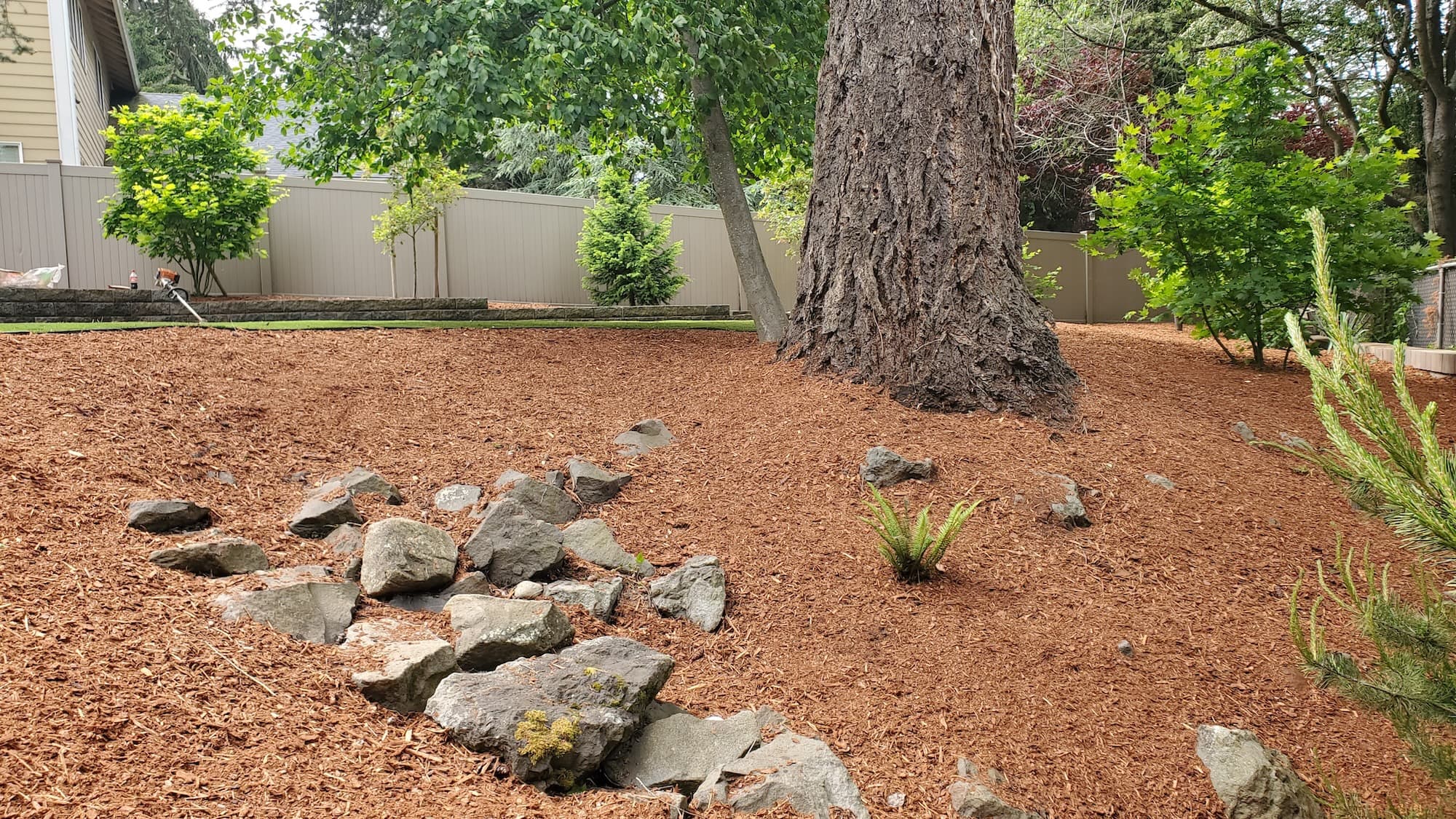West Seattle Pine Straw Mulch Installation
Homeowner’s Issue
West Seattle yards deal with a mix of problems: heavy winter rain, moss-prone shade under big evergreens, compacted soils that hold water in low spots, and windy, salt‑spray exposure on parcels toward Alki. Many homes near Lincoln Park, Admiral and Fauntleroy sit on small slopes or terraces that shed soil when the rains come. That means bare spots, exposed roots, and invasive runners—English ivy and Himalayan blackberry show up quickly in loosened soil. Sun exposure varies block to block; south-facing front yards dry out in summer while north-facing beds stay damp and encourage moss.
HOA sections around the Junction expect tidy beds; curb appeal matters for resale and neighbor standards. Pine straw is a local, lightweight mulch that stabilizes slopes, improves infiltration on compacted soil, and breaks down slowly so you don’t need to replace it every season. Because West Seattle has a long wet season and a short dry window in summer, timing and depth matter: install after major fall rains ease and before spring weeds take hold. We use strictly sustainable methods—no herbicides—so solutions revolve around manual removal, organic soil amendments, and mulch layering that respects your trees, drip lines, and rain patterns.
Our Quality Service
We clear, prep, and install pine straw for lasting, low‑maintenance beds. Our crew uses rakes, hand-tools, and small loaders for larger jobs; we’ll flag roots and irrigation, and work around mature trees. Typical timelines: half-day for small front beds, one day for an average yard, multi-day estimates for steep slopes or major cleanup. We never use chemical herbicides—only manual weed removal, organic compost, and landscape fabric where it makes sense.
Local insight we bring: West Seattle soils often need loosening and organic matter; steep sections need contouring and extra anchoring; exposed areas near Alki benefit from denser straw packing. We plan installs around Seattle’s rainfall patterns and local water‑use advisories, recommending mulch depths (3–4 inches) that reduce watering needs and erosion.
Benefits: safer walkways, reduced erosion, improved curb appeal, fewer weed returns, and a tidy look that lasts through the wet season.
What’s Included
- Onsite assessment and photo-backed estimate.
- Manual weeding and debris removal (roots, ivy, leaves).
- Soil roughening and light amendment where needed.
- Pine straw installation at specified depth (typically 3–4 inches).
- Clean edging and site sweep; haul-away of large green waste if requested.
Options / Upgrades:
- Landscape fabric underlay (where appropriate).
- Organic soil amendment (compost/topdressing).
- Extra anchoring for slopes (staples/no invasive fixings).
- Haul-away vs. green‑bin disposal (we’ll sort compostables).
- Planting small shrubs or native groundcovers to stabilize slopes.
Before & After / Expectations
Expect some noise and a bit of mess during work—we remove it before leaving. Access: we need at least one clear gate, and 2–3 feet of working room along bed edges. For steep or tight-access sites we’ll quote based on manual carry time. Debris: we separate wood, green waste, and trash; compostable material goes to green‑bin or local composting (your choice).
After installation you’ll see immediate visual improvement and less splash on siding and paths. Maintenance: raking and topping every 12–24 months; heavier touch-ups after any major storm. Care tips for West Seattle: install in late spring or early fall when rain is lighter; avoid heavy compaction in winter; watch for ivy regrowth in shaded, damp corners and pull runners before they root.
FAQs
Q: How long does pine straw last in West Seattle?
A: Typically 12–24 months. In highly trafficked or exposed coastal areas it breaks down faster; we recommend topping every year for best appearance.
Q: Do you use chemicals for weed control?
A: No. We use hand removal, mulching, fabric, and organic amendments—no herbicides.
Q: Will pine straw prevent erosion on slopes?
A: It helps a lot for small to moderate slopes when properly anchored and combined with compost and plantings. Very steep areas may need additional stabilization.
Q: How soon can I park or use paths after installation?
A: Paths are usable immediately; avoid heavy yard equipment on fresh straw for 24–48 hours to let it settle.
Q: Do you work with HOA rules?
A: Yes. We’ll review your covenants and recommend plant/mulch profiles that meet common HOA aesthetic rules in West Seattle neighborhoods.
Call to Action
If you live in West Seattle and want a tidy, sustainable yard that actually holds up to our rain and wind, book a free estimate. We schedule quick installs around school and commute hours and can usually fit small jobs within a week. Local crews, practical solutions, and honest pricing.
Email: neatandtidyseattle@gmail.com
Phone: 206-538-9344
Ready to stabilize slopes, cut down maintenance, and make your beds look sharp year‑round? Send photos and a brief note and we’ll reply with a clear estimate.










